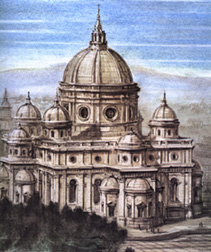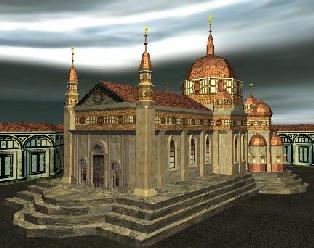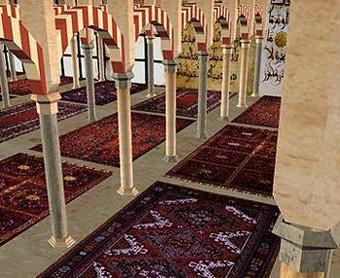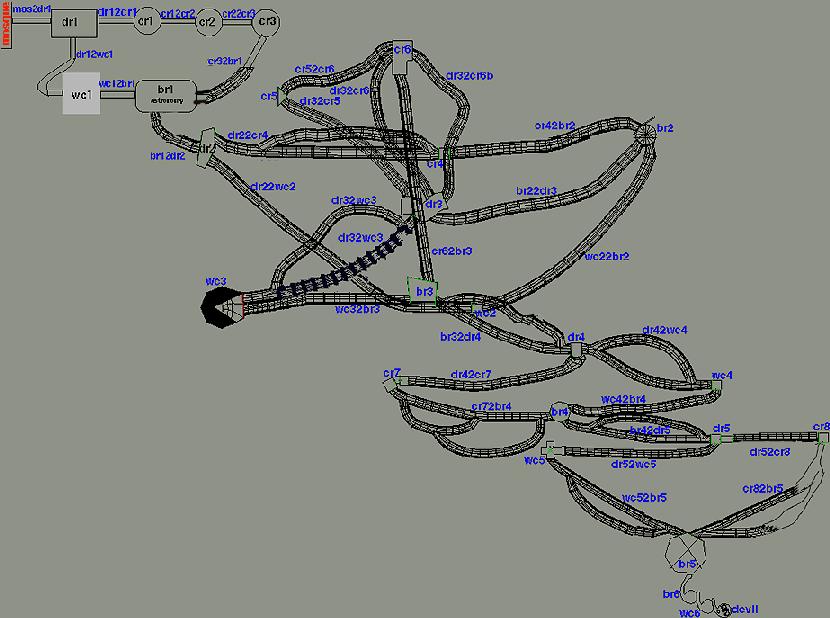

| the entrance | the labyrinth | the finale |
|---|
Mitologies is a virtual reality artwork created for the CAVE. It is loosely based on a number of sources: the Cretan myth of the Minotaur, the Revelation (Apocalypse) of St. John, Dante's "Inferno", and Durer's woodcuts after the revelation. Music from Wagner's "Ring" is used to structure the various narrative motifs. Following this selection of sources, the title Mitologies is a word-game: a synthesis of the word mitos, which in greek is the thread, the ball of string, that Ariadne gave Theseus to help him find his way out of the labyrinth, and mythologies.
The narrative starts out in a linear fashion, a structure fairly unknown to virtual reality work, but familiar to us from other media such as film or literature. The participants that enter the CAVE are initially located on the bank of a calm river. From a distance one can hear the creeking sounds of a wooden boat and the subtle sound of water washing against the river banks. The boat slowly appears, led by a statue: a model of Donatello's Zuccone . As it approaches the shore, the visitors are swiftly transported onto it and their journey down the river begins. In the physical space of the CAVE, two benches are placed in a way that corresponds to the virtual benches of the boat. Thus the illusion of travelling in the boat is very strong, as the viewers can look down at the floor of the CAVE and see the virtual boat rocking beneath their feet.


The river scene eventually fades out while the next scene, that of a
brighter and more ethereal space, fades in. The transition is aided by
sound, an excerpt from Richard Wagner's opening segment of Das Reingold,
which serves as a structural motif for the unfolding narrative. Once in
this space, the participants have disembarked and can now start using the
wand to navigate through the large plane, occupied by horticultural maze
gardens and a magnificent church far in the distance.
The church encountered represents the seven churches described in the
Apocalypse: Ephesus, Smyrna, Pergamum, Thyatira, Sardis, Philadelphia,
and Laodicea. In mitologies, all seven of these churches are represented
as this one grand church, modeled after a Leonardo da Vinci sketch of a
church that was never built.
 |
 |
|---|---|
| Leonardo da Vinci's sketch, although not completed, has
a "rennaisance" look to it
(source: 15.) |
For mitologies, the model was changed to look more
medieval: more ornamental with darker colors and textures.
Click on the church to view more detail |
Surprisingly, the interior of each church opens upon the elaborate space of a completely different style of church: the mosque of Cordoba (17, 18, 19, 20). The visitor may travel inside the close-to-real representation of the mosque or fly high up over its arches.

The end of the mosque is the entrance to the labyrinth.
 |
|---|
Click
on the image above to view some (from a total of over 25) of the rooms
found in the labyrinth.
The last room of the labyrinth is the final destination of the journey.
The shape of this room resembles the number six or the shell of a snail,
as do the two rooms that proceed it. The visitors enter at the narrow tip
of the room and circle around until they reach the center, where the encounter
with the minotaur himself takes place. The representation of the minotaur
seated in his magnificent temple is based on Cesare Ripa's death metaphor
from Iconologia (2).:
The personification of Death, a skeleton, lies on a bier within an elaborate catafalque decorated with skulls and many lamps. He is wrapped in a rich robe (he takes away the rich man's wealth) and wears a laurel crown symbolizing his rule over all mortals. In one hand he holds a sword entwined with an olive branch, meaning that peace cannot endure if men do not run the risk of death in fighting for it. The motto above the catafalque reads: "Death makes all men equal." Four lighted tapers stand on either side of the bier.
In the lower foreground stand two putti, heavily veiled to signify their blindness, not their mourning, for they represent man's pleasure in the things of this world. The power and glory of the world are shown in the child wearing classical armor and carrying crowns, a mitre, a scepter, and medals on a cushion, while a sword, lances, and a marshal's baton lie at his feet. The other putto represents all human invention and art; the flail and shovel lying near him stand for agriculture, while the quill pens, scrolls, palette and brushes, and compass and triangle stand for the arts and sciences.
